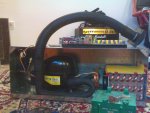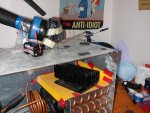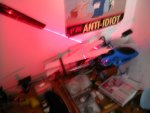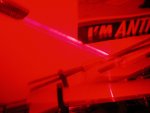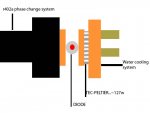brtaman
0
- Joined
- Jun 12, 2008
- Messages
- 1,199
- Points
- 48
Hello everyone,
I am new to this forum (been reading for quite a while). I have a few burner diodes salvaged from dvd burners, a DX true 50 and a 803t blu ray diode on the way. I run the diodes through the DDL driver, that was graciously posted on here by deadal.
My questions, what would the effect of super-cooling a diode, not true super cooling...only in the -50-60C range...have on the laser diodes function?
I have a phase-change cooling system left over from my computer overclocking days (still hold the WR for a CPU ), and have been trying to find a good use for it. The system is run by a 1/2 hp Danfoss compressor, it uses r-402a gas (good temp and capacity). It can handle a 150w at around -47 C, so I believe the <1w load from the laser shouldnt be a problem
), and have been trying to find a good use for it. The system is run by a 1/2 hp Danfoss compressor, it uses r-402a gas (good temp and capacity). It can handle a 150w at around -47 C, so I believe the <1w load from the laser shouldnt be a problem  . However on the other hand I am thinking whether or not the laser will even be able to lase at such a cold temperature (as they usually need a couple of seconds of heating up before they run at their full potential).
. However on the other hand I am thinking whether or not the laser will even be able to lase at such a cold temperature (as they usually need a couple of seconds of heating up before they run at their full potential).
What are your thoughts on the subject? At the moment I have a ton of work to do, but I will be trying out the experiment as soon as I have time!
I attached an old picture of the system, to give you better idea of the type of cooling system I am referring to (basically a superpowered-concentrated fridge)
Thanks
brtaman
I am new to this forum (been reading for quite a while). I have a few burner diodes salvaged from dvd burners, a DX true 50 and a 803t blu ray diode on the way. I run the diodes through the DDL driver, that was graciously posted on here by deadal.
My questions, what would the effect of super-cooling a diode, not true super cooling...only in the -50-60C range...have on the laser diodes function?
I have a phase-change cooling system left over from my computer overclocking days (still hold the WR for a CPU
What are your thoughts on the subject? At the moment I have a ton of work to do, but I will be trying out the experiment as soon as I have time!
I attached an old picture of the system, to give you better idea of the type of cooling system I am referring to (basically a superpowered-concentrated fridge)
Thanks
brtaman


